The Predisposition Biomarkers Market is estimated to be valued at USD 5.6 billion in 2025 and is projected to reach USD 12.4 billion by 2035, registering a compound annual growth rate (CAGR) of 8.2% over the forecast period.
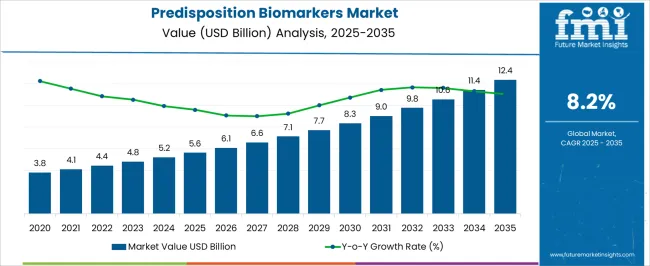
| Metric | Value |
|---|---|
| Predisposition Biomarkers Market Estimated Value in (2025 E) | USD 5.6 billion |
| Predisposition Biomarkers Market Forecast Value in (2035 F) | USD 12.4 billion |
| Forecast CAGR (2025 to 2035) | 8.2% |
The Predisposition Biomarkers market is expanding steadily, supported by the growing demand for early detection tools and risk assessment technologies that enable proactive healthcare management. The current landscape reflects heightened investment in genomics, molecular diagnostics, and precision medicine, which has encouraged broader adoption of biomarker-based screening programs across healthcare systems. Rising incidences of lifestyle-related and genetic disorders have intensified the emphasis on preventive care, making predisposition biomarkers a crucial element in identifying at-risk populations.
Technological progress in next-generation sequencing, bioinformatics, and high-throughput assays has increased test accuracy and scalability, further accelerating adoption. Additionally, the integration of biomarkers into clinical decision-making frameworks is being reinforced by a growing focus on value-based healthcare and personalized treatment strategies.
As patient awareness about genetic risks expands and governments continue to strengthen funding for predictive diagnostics, the future outlook of this market is highly promising The trajectory points toward increased use of biomarkers as foundational tools in preventive medicine and healthcare optimization globally.
The predisposition biomarkers market is segmented by application, end user, and geographic regions. By application, predisposition biomarkers market is divided into Oncology, Deep Vein Thrombosis, Neurological Diseases, Alzheimer’S Disease, Coronary Disease, and Others. In terms of end user, predisposition biomarkers market is classified into Hospitals, Contract Research Organizations, and Academic Research Institutes. Regionally, the predisposition biomarkers industry is classified into North America, Latin America, Western Europe, Eastern Europe, Balkan & Baltic Countries, Russia & Belarus, Central Asia, East Asia, South Asia & Pacific, and the Middle East & Africa.
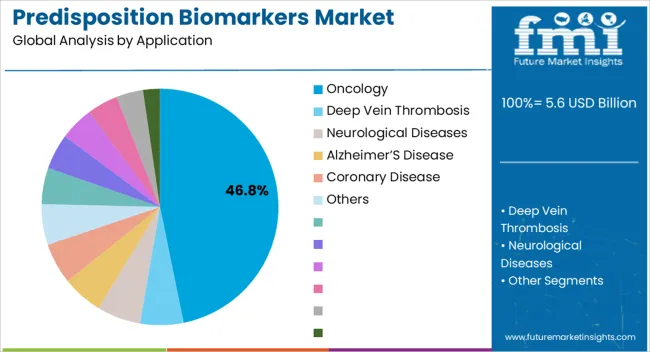
The oncology application segment is expected to account for 46.80% of the Predisposition Biomarkers market revenue in 2025, positioning it as the dominant area of application. This leadership is being attributed to the rising global burden of cancer and the growing reliance on predictive diagnostics to identify individuals at elevated risk. The integration of predisposition biomarkers into oncology has been reinforced by advances in genetic sequencing and molecular profiling, which allow early identification of cancer susceptibility.
Clinical adoption has been accelerated by the ability of biomarkers to guide targeted prevention strategies and facilitate closer monitoring of high-risk patients. Hospitals and research institutions have increasingly prioritized oncology biomarkers as part of cancer management protocols, which has further strengthened demand.
The continuous expansion of precision oncology programs and the emphasis on detecting hereditary cancer syndromes have also driven growth As early detection remains central to improving outcomes and reducing treatment costs, oncology applications are expected to sustain their strong position in the market.
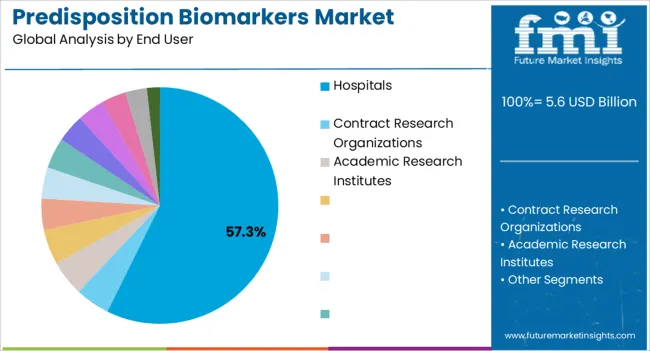
The hospitals end user segment is projected to hold 57.30% of the Predisposition Biomarkers market revenue in 2025, making it the largest consumer group. This dominance is being driven by the pivotal role hospitals play in delivering genetic testing and counseling services, coupled with their capacity to integrate biomarker-based diagnostics into routine clinical workflows. Hospitals serve as central points for patient screening, diagnosis, and risk management, which makes them natural adopters of predisposition biomarker technologies.
Increased investment in advanced diagnostic infrastructure and the growing availability of in-house genomic testing laboratories have further supported the adoption of these tools in hospital settings. Hospitals also benefit from strong collaborations with research centers and biotechnology companies, enabling them to stay at the forefront of biomarker innovation.
As patient demand for comprehensive care and personalized medicine grows, hospitals are expected to maintain their leadership by expanding preventive care programs The emphasis on early detection and risk stratification within hospital systems will continue to propel their share of the market forward.
Biomarkers are been used in clinical medicine foe early diagnosis and effective treatment of many disease. Predisposition biomarkers are indicators of the natural characteristics of organism which makes it more susceptible to the effects of an exposure to a chemical. Predisposition biomarkers are biomarkers which is associated with increased or decreased chance of developing a disease or medical condition. Predisposition Biomarkers is genetic biomarkers which indicates whether the individual has increased likelihood of developing cancer later in life.
Predisposition biomarkers may be detected many years before the appearance of clinical signs and symptoms. Predisposition biomarkers do not describe a relationship to any specific treatment. Predisposition biomarkers like BRCA1/2 mutation is used to evaluate the likelihood of developing breast and ovarian cancers. Predisposition biomarkers is used to determine whether nutritional, lifestyle, or other preventive interventions are indicated. Predisposition biomarkers shares properties with prognostic biomarkers as they indicate risk for certain future occurrence of a disease-related event.
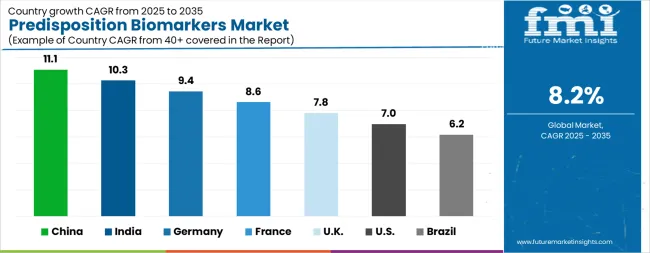
| Country | CAGR |
|---|---|
| China | 11.1% |
| India | 10.3% |
| Germany | 9.4% |
| France | 8.6% |
| UK | 7.8% |
| USA | 7.0% |
| Brazil | 6.2% |
The Predisposition Biomarkers Market is expected to register a CAGR of 8.2% during the forecast period, exhibiting varied country level momentum. China leads with the highest CAGR of 11.1%, followed by India at 10.3%. Developed markets such as Germany, France, and the UK continue to expand steadily, while the USA is likely to grow at consistent rates. Brazil posts the lowest CAGR at 6.2%, yet still underscores a broadly positive trajectory for the global Predisposition Biomarkers Market. In 2024, Germany held a dominant revenue in the Western Europe market and is expected to grow with a CAGR of 9.4%. The USA Predisposition Biomarkers Market is estimated to be valued at USD 2.1 billion in 2025 and is anticipated to reach a valuation of USD 4.1 billion by 2035. Sales are projected to rise at a CAGR of 7.0% over the forecast period between 2025 and 2035. While Japan and South Korea markets are estimated to be valued at USD 295.3 million and USD 161.6 million respectively in 2025.
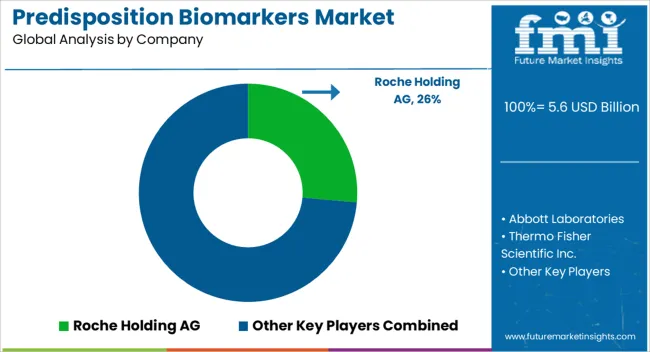
| Item | Value |
|---|---|
| Quantitative Units | USD 5.6 Billion |
| Application | Oncology, Deep Vein Thrombosis, Neurological Diseases, Alzheimer’S Disease, Coronary Disease, and Others |
| End User | Hospitals, Contract Research Organizations, and Academic Research Institutes |
| Regions Covered | North America, Europe, Asia-Pacific, Latin America, Middle East & Africa |
| Country Covered | United States, Canada, Germany, France, United Kingdom, China, Japan, India, Brazil, South Africa |
| Key Companies Profiled | Roche Holding AG, Abbott Laboratories, Thermo Fisher Scientific Inc., QIAGEN N.V., Illumina Inc., PerkinElmer Inc., Bio-Rad Laboratories Inc., Hologic Inc., Agilent Technologies Inc., Myriad Genetics Inc., and Exact Sciences Corporation |
The global predisposition biomarkers market is estimated to be valued at USD 5.6 billion in 2025.
The market size for the predisposition biomarkers market is projected to reach USD 12.4 billion by 2035.
The predisposition biomarkers market is expected to grow at a 8.2% CAGR between 2025 and 2035.
The key product types in predisposition biomarkers market are oncology, deep vein thrombosis, neurological diseases, alzheimer’s disease, coronary disease and others.
In terms of end user, hospitals segment to command 57.3% share in the predisposition biomarkers market in 2025.






Our Research Products

The "Full Research Suite" delivers actionable market intel, deep dives on markets or technologies, so clients act faster, cut risk, and unlock growth.

The Leaderboard benchmarks and ranks top vendors, classifying them as Established Leaders, Leading Challengers, or Disruptors & Challengers.

Locates where complements amplify value and substitutes erode it, forecasting net impact by horizon

We deliver granular, decision-grade intel: market sizing, 5-year forecasts, pricing, adoption, usage, revenue, and operational KPIs—plus competitor tracking, regulation, and value chains—across 60 countries broadly.

Spot the shifts before they hit your P&L. We track inflection points, adoption curves, pricing moves, and ecosystem plays to show where demand is heading, why it is changing, and what to do next across high-growth markets and disruptive tech

Real-time reads of user behavior. We track shifting priorities, perceptions of today’s and next-gen services, and provider experience, then pace how fast tech moves from trial to adoption, blending buyer, consumer, and channel inputs with social signals (#WhySwitch, #UX).

Partner with our analyst team to build a custom report designed around your business priorities. From analysing market trends to assessing competitors or crafting bespoke datasets, we tailor insights to your needs.
Supplier Intelligence
Discovery & Profiling
Capacity & Footprint
Performance & Risk
Compliance & Governance
Commercial Readiness
Who Supplies Whom
Scorecards & Shortlists
Playbooks & Docs
Category Intelligence
Definition & Scope
Demand & Use Cases
Cost Drivers
Market Structure
Supply Chain Map
Trade & Policy
Operating Norms
Deliverables
Buyer Intelligence
Account Basics
Spend & Scope
Procurement Model
Vendor Requirements
Terms & Policies
Entry Strategy
Pain Points & Triggers
Outputs
Pricing Analysis
Benchmarks
Trends
Should-Cost
Indexation
Landed Cost
Commercial Terms
Deliverables
Brand Analysis
Positioning & Value Prop
Share & Presence
Customer Evidence
Go-to-Market
Digital & Reputation
Compliance & Trust
KPIs & Gaps
Outputs
Full Research Suite comprises of:
Market outlook & trends analysis
Interviews & case studies
Strategic recommendations
Vendor profiles & capabilities analysis
5-year forecasts
8 regions and 60+ country-level data splits
Market segment data splits
12 months of continuous data updates
DELIVERED AS:
PDF EXCEL ONLINE
EPO Biomarkers Market Size and Share Forecast Outlook 2025 to 2035
Vitamin Biomarkers Market Size and Share Forecast Outlook 2025 to 2035
Molecular Biomarkers For Cancer Detection Market Size and Share Forecast Outlook 2025 to 2035
Prognostic Biomarkers Market
Neurological Biomarkers Market Size and Share Forecast Outlook 2025 to 2035
Asthma and COPD Biomarkers Market
Diagnostic Exosome Biomarkers Market Trends – Growth & Forecast 2025 to 2035
Cognitive Impairment Biomarkers Market Size and Share Forecast Outlook 2025 to 2035
MRI-based Quantitative Biomarkers Market Analysis - Size, Share, and Forecast Outlook 2025 to 2035

Thank you!
You will receive an email from our Business Development Manager. Please be sure to check your SPAM/JUNK folder too.
Chat With
MaRIA